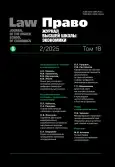The Right for Image of a Citizen: Issues of Implementation
- Autores: Khodyreva E.1
-
Afiliações:
- Udmurtian State University
- Edição: Volume 18, Nº 2 (2025)
- Páginas: 164-189
- Seção: Russian Law: Condition, Perspectives, Commentaries
- URL: https://journal-vniispk.ru/2072-8166/article/view/317616
- DOI: https://doi.org/10.17323/2072-8166.2025.2.164.189
- ID: 317616
Citar
Texto integral
Resumo
Palavras-chave
Sobre autores
E. Khodyreva
Udmurtian State University
Email: eay.07@mail.ru
ORCID ID: 0000-0001-6767-2387
Bibliografia
- Bogustov A.A. (2023) The right of a person to an image in the legislation of the states of the Eurasian region: a comparative analysis. Vestnik Saratovakoy juridicheskoy akademii=Bulletin of Saratov Law Academy, no. 1, pp. 274–285 (in Russ.)
- Bogustov A.A. (2023) Digital image (copy of personality) in the system of objects of civil rights: experience of model legislation. Yuridicheskij vestnik Samarskogo universiteta=Law Bulletin of Samara University, no. 4, pp. 8–13 (in Russ.)
- Cherepakhin B.B. (2001) Protection of personal rights of citizens not related to property rights. In: Anthology of the Ural Civil Law. 1925–1989: Collection of articles. Moscow: Statut, 431 p. (in Russ.)
- Cherepakhin B.B. (2001) Works on civil law. Moscow: Statut, 479 p. (in Russ.)
- Erdelevskiy A.M. (2007) On protection of image of human being. SPS Consultant Plus (in Russ.)
- Fleishits E.A. (2007) Selected works. Moscow: Kontrakt, 480 p. (in Russ.).
- Gavrilov E. (2015) Protection of the external appearance and protection of the image of a citizen. Khozyajstvo i pravo=Economy and Law, no. 10, pp. 13–25 (in Russ.)
- Grimm D.D. (2007) The doctrine of the objects of rights. Vestnik grazhdanskogo prava=Bulletin of Civil Law, no. 1. SPS Consultant Plus (in Russ.)
- Ioffe O.S. (2010) Personal non-property rights and their place in the system of Soviet civil law. In: Selected works. Vol. IV. Saint Petersburg: Yuridicheskij centr Press, 681 p. (in Russ.)
- Kashanin A.V. (2009) The issue of disposing of the author’s personal non-property rights. Vestnik grazhdanskogo prava=Bulletin of Civil Law, no. 4, pp. 43–98 (in Russ.)
- Makovsky A.L. (2010) On the codification of civil law (1922-2006). Moscow: Statut, 734 p. (in Russ.)
- Maleina M.N. (2000) Personal non-property rights of citizens: concept, implementation, protection. Moscow: MZ Press, 242 p. (in Russ.).
- Mikryukov V.A. (2013) Subject-time limits of protection of the image of a citizen. Yurist=Lawyer, no. 4, pp. 3–8 (in Russ.).
- Podrabinok E.M. (2019) Legal protection of children‘ rights in publication and image field. Semeinoe i zhilishnoe pravo=Family and Shelter Law, no. 5, pp. 14–18 (in Russ.)
- Sherstobitov A.E. (2023) Civil law regulation of the right to honor, dignity and business reputation and the right to the image of a citizen. Grazhdanskoe pravo=Civil Law, no. 2, pp. 8–13 (in Russ.)
Arquivos suplementares








